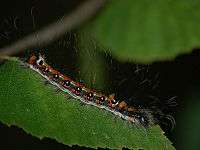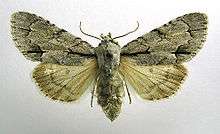Dark dagger
The dark dagger (Acronicta tridens) is a moth of the family Noctuidae. It is distributed throughout Europe (from southern Fennoscandia to the Balkans and Italy), Turkey, the Near East, the European part of Russia, southern Siberia, the Ural, the Russian Far East (Primorye, southern Khabarovsk, southern Amur region and Sakhalin), the Korean Peninsula, China and Japan (Hokkaido).

| Dark dagger | |
|---|---|
 | |
| Scientific classification | |
| Kingdom: | Animalia |
| Phylum: | Arthropoda |
| Class: | Insecta |
| Order: | Lepidoptera |
| Superfamily: | Noctuoidea |
| Family: | Noctuidae |
| Genus: | Acronicta |
| Species: | A. tridens |
| Binomial name | |
| Acronicta tridens (Denis & Schiffermüller, 1775) | |
This species has grey forewings marked with bold black "daggers". The hindwings of the males are white, those of the females dirty grey. The wingspan is 35–43 mm. Adults of this species are extremely similar to the grey dagger (Acronicta psi). Despite the common name, the dark dagger is usually the paler of the two species and the white hindwings of the male are usually diagnostic. However, the only reliable way of distinguishing adults of the two species is by examination of the genitalia. The larvae, however, are very different (see below). This species flies at night in June and July and is attracted to light and sometimes to sugar.
The larva is black, marked with red and white stripes, without the bold yellow markings and prominent horn of the larva of the grey dagger. It feeds on a variety of plants (see list below). This species overwinters as a pupa, sometimes spending two winters in this form.
- ^ The flight season refers to the British Isles. This may vary in other parts of the range.
Recorded food plants
- Betula - Birch
- Caragana
- Crataegus - Hawthorn
- Malus - Apple
- Prunus
- Pyrus - Pear
- Rhamnus - Buckthorn
- Rosa - Rose
- Salix - Willow
- Sorbus - Rowan
References
- Chinery, Michael Collins Guide to the Insects of Britain and Western Europe 1986 (Reprinted 1991)
- Skinner, Bernard Colour Identification Guide to Moths of the British Isles 1984
External links
| Wikimedia Commons has media related to Acronicta tridens. |
| Wikispecies has information related to Acronicta tridens |